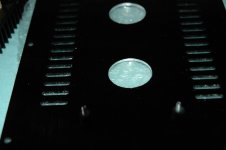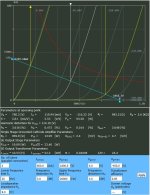The hole idea was to use a small and light transformer.
Audionote Ankoru has double the footprint and quadruple the weight compared to my amplifier.
Max power of LL1623 at 30Hz is 13W, not 25.
Audionote Ankoru has double the footprint and quadruple the weight compared to my amplifier.
Max power of LL1623 at 30Hz is 13W, not 25.
Hi Filenet,
With use of the LL1623 OPT, your parallel 845 would produce max of 13 watts. Is that all you expected?
Johnny
With use of the LL1623 OPT, your parallel 845 would produce max of 13 watts. Is that all you expected?
Johnny
Two 845 in parallel will have an internal resistance in the territory of 300B.
You can see it that way, an 300b amp with 845 beauties.I expect better THD and damping factor.
You can see it that way, an 300b amp with 845 beauties.I expect better THD and damping factor.
I know that aprox 250W dissipation (not considering transformers losses) for an output of 13W, giving 5% efficiency, may look depressing.
Last edited:
It is an 1.5mm aluminum plate with 35um copper layer. Front and back are the same.

I thought alu and copper don’t match very well (corrosion) when they have direct contact.
Perhaps this is only when moisture / water is added?
Regards, Gerrit
Perhaps this is only when moisture / water is added?
Regards, Gerrit
There is an 100um isolating layer between aluminum plate and copper layer.
Coper surface is painted by me with rosin diluted in isopropyl alcohol, that is why it shines in pictures.
Coper surface is painted by me with rosin diluted in isopropyl alcohol, that is why it shines in pictures.
Final schematic with some changes:
-DC for DHT heaters
-added 40s HV delay for input/driver
-47K loading resistors for inter stage transformer
-1K grid stoppers for 845s






-DC for DHT heaters
-added 40s HV delay for input/driver
-47K loading resistors for inter stage transformer
-1K grid stoppers for 845s
I think that might not be substantial enough. I use 3mm if it is load supporting and subject to the stress of tube replacement. Is it possible you might need to double it up or add some cross members?It is an 1.5mm aluminum plate with 35um copper layer
Even 2mm is too much for my tools(a power drill, a fine and a saw). 3mm calls for a metal shop, which unfortunately I do not have at my disposal. I wanted to be true diy. The chassis is enough stiff, you do not have to be too analytical about it, consider that I used 1mm steel.
I manage 3mm at home fine. I have to have well greased hole punchs, but otherwise it is not an issue. The top plate below was done on the kitchen table. The air vents aren't perfectly aligned, otherwise, apart from being a bit time consuming, it was quite straightforward.
In your case couldn't you just put another sheet on top and use the holes already cut as a template? I can assure you 1.5mm is pretty flimsy.
In your case couldn't you just put another sheet on top and use the holes already cut as a template? I can assure you 1.5mm is pretty flimsy.
Attachments
I use step drills (with WD40 as cooling/greasing liquid) for 2-3mm aluminium plates, mostly with column drill (up to 32mm).Even 2mm is too much for my tools(a power drill, a fine and a saw). 3mm calls for a metal shop, which unfortunately I do not have at my disposal. I wanted to be true diy. The chassis is enough stiff, you do not have to be too analytical about it, consider that I used 1mm steel.

My metalwork skills are pretty limited, i must admit.
Where do you find 3mm aluminum cut in 255/305 size?
You may be surprised how stiff is 1.5mm sheet with lateral heatsinks. This is the minimum requirement for me, only if you want to put like 60kg on top of it, you may have problems, which is not the case.
Of course 3mm is always better.
Where do you find 3mm aluminum cut in 255/305 size?
You may be surprised how stiff is 1.5mm sheet with lateral heatsinks. This is the minimum requirement for me, only if you want to put like 60kg on top of it, you may have problems, which is not the case.
Of course 3mm is always better.
- Home
- Amplifiers
- Tubes / Valves
- AD1 PP driver

